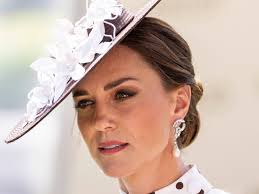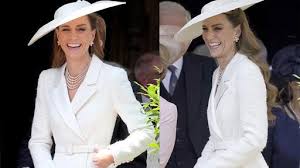Princess Kate’s highly anticipated return to Royal Ascot was put on pause this week, as she missed the June 18 event despite being listed on the schedule. Prince William attended solo, sparking widespread concern and curiosity about his wife’s continued recovery following her public battle with cancer.
While the Princess of Wales had been expected to make an appearance—marking what would have been her first Royal Ascot since her diagnosis—her absence serves as a poignant reminder of the unpredictable nature of cancer recovery. Just days earlier, she had joined other senior royals at the Order of the Garter service in Windsor and stood proudly at the Trooping the Colour celebration for King Charles’ birthday. These back-to-back public appearances were widely seen as a triumphant return to royal duties.
However, her decision to skip Royal Ascot appears to reflect the personal wisdom and caution she previously emphasized in her cancer journey: knowing when to rest, and accepting that healing comes in waves—not straight lines.
In June 2024, Princess Kate was absent from Royal Ascot due to active chemotherapy treatment. At the time, she publicly acknowledged her health challenges and spoke candidly about the unpredictability of her condition. “As anyone going through chemotherapy will know, there are good days and bad days,” she stated, in a message that resonated with millions around the world.
Her transparency was both humbling and empowering. She admitted that patience was not just a virtue but a necessity during such a transformative period. Her words offered solace to others facing similar battles: “I’m learning how to be patient, especially with uncertainty.”
By September, Kate had completed her chemotherapy, and in January, she shared the hopeful news that her cancer was in remission. Yet, she tempered celebration with realism, saying, “It takes time to adjust to a new normal.” It was a subtle but powerful reminder that remission does not mark the end of the journey, but the beginning of a new phase—one that still requires care, rest, and self-awareness.
While the Royal Ascot is one of the most glamorous events on the British social calendar, complete with horses, hats, and high society, Princess Kate’s decision to sit this one out highlights the quiet strength of honoring one’s limits.
Her absence wasn’t a disappearance; it was a deliberate act of self-care. The royal family has increasingly emphasized mental and physical wellness, especially as both King Charles and Princess Kate have navigated personal health crises this year. Her recent return to royal events was met with admiration and excitement, but also underscored just how much she had been through—and how carefully she continues to navigate her recovery.
For many battling or recovering from cancer, Kate’s story is more than just one of royalty. It’s a shared reality. You may feel fine one day, only to need complete rest the next. You may make big plans, then cancel at the last minute—not out of laziness or flakiness, but out of sheer necessity. These fluctuations aren’t weaknesses; they’re evidence of a battle bravely fought and a body slowly rebuilding.
The Princess of Wales has always approached her royal duties with grace and deep commitment, often praised for her poise and accessibility. But in recent months, her most powerful moments have come not from waving on balconies or donning tiaras, but from sharing personal truths that humanize her—and make her one of the most relatable members of the royal family.

Balancing the weight of public expectation with the demands of personal recovery is no small feat. Her appearances at events like Trooping the Colour and the Order of the Garter were not just ceremonial—they were acts of courage, made under intense scrutiny. Every wave, smile, and outfit carried deeper meaning: she’s still here, she’s still fighting, and she’s doing it with dignity.
But skipping Royal Ascot is a statement too. It’s a quiet declaration that her health comes first. And that’s a message worth amplifying.
Following Kate’s health disclosures, the outpouring of public support has been both overwhelming and heartfelt. Her openness has shifted public dialogue around cancer, encouraging more empathy and less pressure to “bounce back.”
When she first revealed her diagnosis, she said she was “focused on recovery” and “looking forward to a fulfilling year ahead.” She added that there was “much to look forward to.” These sentiments echoed the feelings of countless others navigating survivorship—a complex space that’s equal parts hope, caution, and recalibration.
As Kate continues her journey, the public has shown a remarkable willingness to meet her where she is—celebrating her presence, but also respecting her absences. Her story is no longer just one of a royal resuming her duties. It’s the story of a woman prioritizing her health, her family, and her future.
Interestingly, Princess Kate is not the only royal managing serious health issues. King Charles III is also undergoing treatment for cancer. His recent public engagements have similarly been praised, with each appearance symbolizing resilience and duty in the face of adversity.
Together, their stories have brought a sobering but necessary lens to monarchy: behind the pomp and pageantry are real people grappling with real-life battles.
As of now, Kensington Palace has not issued a formal statement on Princess Kate’s decision to skip Royal Ascot. Given her prior remarks about “good days and bad days,” it’s likely the choice was made to prioritize rest over ritual. And while that may disappoint royal watchers and fans of the event, it’s an entirely understandable—and admirable—decision.
In the coming weeks, it’s expected that the Princess of Wales will continue to appear selectively at engagements that align with her energy levels and recovery status. Her ability to gracefully weave public service into personal healing may well become a model for modern monarchy—and for anyone trying to re-enter life after illness.

Princess Kate’s absence from Royal Ascot is not a retreat—it’s a revelation. It reveals that strength is not just in showing up, but in knowing when not to. That healing is not linear, and that sometimes, the most powerful thing you can do is listen to your body and choose rest.
Her story continues to unfold, marked not just by tiaras and traditions, but by the timeless power of human resilience. And in this moment of absence, she’s reminded the world of something truly royal: grace under pressure, and the courage to heal on her own terms.



